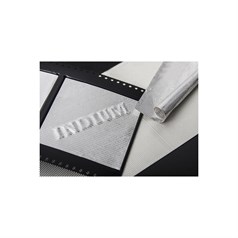- Home
- Solders, Fluxes and Preforms
- Thermal Interface Materials
Thermal Interface Materials
Thermal interface materials (shortened to TIMs) are products used to transfer heat between mated surfaces. Their most common function is heat dissipation. They are often used in applications where air or liquid cooling is not available. Using TIMs reduces the risk of overheating. This, in turn, improves a device's performance and lifetime.
Thermal interface materials are inserted between a heat-producing device (e.g. a semiconductor) and a heat-dissipating device (e.g. a heat sink). This removes air gaps that would lead to poor heat conduction. Interfacing surfaces with TIMs allows to transfer and remove heat quickly.
Conro offers a wide choice of thermal interface materials from major manufacturers such as Indium.
Conro is an authorized distributor for Indium.
Types of thermal interface materials
The choice of a TIM must to be tailored to the specific needs of the application. Thermal conductivity, ease of application/rework and mechanical properties all need to be considered. Long-term stability is also an important factor.
- Thermal paste, putty, gel or grease. These materials are in liquid state. They provide a thin bond line between surfaces. Their thermal resistance is very low. Most of these MITs do not cure and have small mechanical strength. They are electrically non-conductive.
- Thermal adhesive. Like the previous materials, adhesives provide a thin bond line. However, these products cure after application. This offers a superior mechanical bond.
- Thermal tape. Easy to apply, requires no curing time. Tape provides the advantage of transferring heat and holding a structure mechanically.
- Thermally conductive pad. Solid pads, mostly made of silicone. Easy to apply. Pads provide a combination of high thermal conductivity and softness. These features reduce mechanical stress while maintaining thermal performance.
- Phase-change materials. These materials change from solid to liquid state at about 60°C. When solid, they can be easily handled. At liquid state, they fill all the gaps between mated surfaces.





